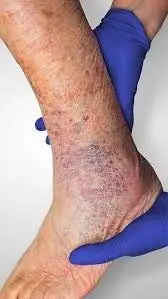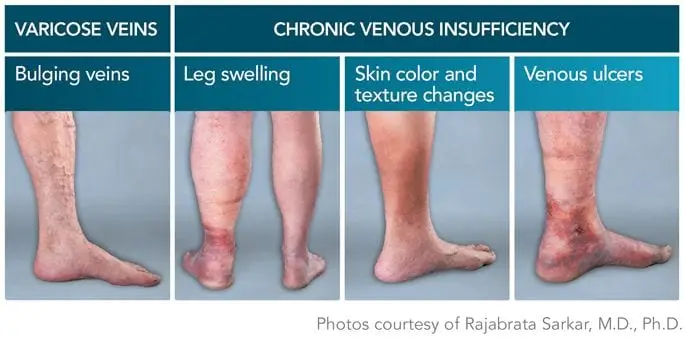Page Contents
Venous ulcers, also known as stasis ulcers, are chronic wounds that primarily form on the lower legs, particularly around the ankles. They develop when blood flow through the veins is compromised, leading to increased pressure in the affected veins. This buildup of pressure damages the skin and surrounding tissues, resulting in ulcers. Venous ulcers are slow to heal and can cause significant discomfort, making them a common and persistent issue in elderly populations, particularly those with underlying venous insufficiency.

Statistics and risk factors
Venous ulcers are more prevalent in individuals over the age of 60, with age being a major risk factor. In fact, research suggests that between 1 – 3% of individuals over 65 experience venous ulcers, with the incidence increasing with age.
Women tend to be more affected than men, likely due to hormonal changes, pregnancy, and prolonged standing occupations like nursing and teaching. Certain racial groups, such as Caucasians, appear to have a slightly higher prevalence compared to others, although lifestyle and environmental factors may play a larger role than race alone.

Obesity significantly increases the risk of venous ulcers because it adds extra pressure to the lower limbs, making blood circulation more challenging. Occupations that involve long periods of standing or sitting, such as factory work, retail, or office jobs, can also increase the risk. Additionally, a genetic predisposition to venous insufficiency or varicose veins can contribute to the development of these ulcers, though lifestyle factors often play a stronger role.
Causes of venous ulcers
Venous ulcers result from chronic venous insufficiency (CVI), a condition in which the veins in the legs are unable to pump blood efficiently back to the heart. This failure can occur due to damaged vein valves, which allow blood to flow backward and pool in the veins. Over time, this pooling increases pressure and weakens the surrounding tissue, eventually leading to ulcer formation. Conditions like varicose veins, deep vein thrombosis (DVT), or a history of leg injuries can all contribute to the development of CVI and, by extension, venous ulcers. Prolonged inactivity, immobility, and standing or sitting for extended periods worsen blood circulation, increasing the likelihood of developing these ulcers.
Signs, symptoms, and potential complications
Early signs of venous ulcers include swelling in the lower legs, skin discoloration (often brown or reddish), and a heavy or aching sensation in the legs. The skin may become dry, flaky, or itchy, and small areas of open sores may appear, which are typically shallow but can grow larger over time. These ulcers are slow to heal and may ooze or become infected, causing pain, swelling, and foul-smelling discharge.
While venous ulcers themselves are not usually life-threatening, they can lead to serious complications if left untreated. These include cellulitis (a skin infection), deep infections, and even osteomyelitis (infection of the underlying bone). Chronic pain, immobility, and the risk of sepsis (a life-threatening infection) can further complicate the condition, especially in elderly patients with weaker immune systems.
Treatment and medication options
Treatment for venous ulcers primarily focuses on improving blood circulation in the legs and managing the wound to promote healing. Compression therapy using specially designed stockings or bandages is the first line of treatment, as it helps reduce swelling and encourages better blood flow. Wound care is also essential, with regular cleaning, debridement (removal of dead tissue), and application of dressings that promote a moist healing environment.
Medications may include topical or oral antibiotics if the ulcer is infected, as well as pain relief medications. In some cases, pentoxifylline, a drug that improves blood flow, or aspirin, which has anti-inflammatory properties, may be prescribed to aid in healing. Surgical options, such as vein ablation or stripping, may be considered for severe cases where the underlying venous problem needs to be addressed.
Alternative and natural treatments
Alternative treatments, such as herbal remedies and supplements, are sometimes used to promote wound healing or improve circulation. Horse chestnut extract and Gotu kola are believed to strengthen blood vessel walls and reduce swelling. Some patients also turn to honey-based dressings, which have antibacterial properties and may promote healing. However, these treatments should always be discussed with a healthcare provider, as evidence of their effectiveness is still limited.
Is venous ulcer preventable?
Venous ulcers can often be prevented, especially in individuals at higher risk. Key preventive measures include maintaining a healthy weight, exercising regularly to improve circulation, and avoiding long periods of sitting or standing. Elevating the legs and wearing compression stockings can also help reduce the likelihood of developing ulcers in those with known venous insufficiency.
Diet and lifestyle modifications are also crucial. Eating a balanced diet rich in antioxidants, vitamins C and E, and omega-3 fatty acids can promote healthy blood vessels and reduce inflammation. Staying hydrated and avoiding excessive salt intake can help manage swelling. For smokers, quitting is essential, as smoking damages blood vessels and exacerbates circulation problems.
Conclusion
While venous ulcers can be a challenging condition, they are both preventable and treatable with the right care and lifestyle adjustments. By recognising the early signs and taking proactive steps to improve circulation and manage risk factors, individuals can significantly reduce their chances of developing venous ulcers. For those already affected, early treatment can lead to better outcomes and a quicker recovery, preventing complications and improving quality of life.

